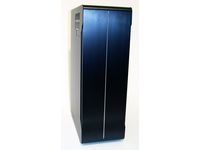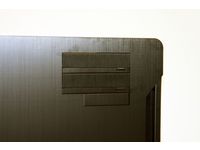Four Full Tower Cases From $150 To $600
ABS Canyon 695--Unpacking And Build
$600
Unpacking
You know a product needs serious protection when you open one box and find another box inside. That’s how the Canyon 695 is shipped, and unwrapping it almost felt like a Christmas tease. Upon popping open the second box, I got my first peek at the ABS chassis—otherwise known as Lian Li’s PC-X2000, which is being sold exclusively by ABS in North America under the Canyon marquee. There’s no other way to put this: the thing is gigantic. And yet it’s remarkably light as a result of its all-aluminum construction.
Alright, step one out of the way—pull the case from its packing material. Step two: open it up and check out the interior. Ah, but the Canyon 695 isn’t your everyday full tower chassis. In fact, it’s completely different from any other chassis in this piece. Enough so, in fact, that its $600 price tag almost makes it incomparable in a roundup of significantly more affordable boxes. I’ll go into further detail in the build section, but suffice to say, it took several glances at the installation guide before figuring out how it came apart. One thumb screw on the left and another on the right; pull each, and remove both sound-insulated side panels, revealing the box of goodies that ABS includes.
Never mind those SATA cables that came with your motherboard. Inside the Canyon’s accessory bundle, you’ll find six short, black cables to attach hard drives and two long ones able to reach optical drives at the top of the case. Black zip ties and clamps keep things neat without breaking the Canyon’s dark color scheme. ABS even adds a screwdriver for installing motherboard standoffs and a clear plastic box for spare parts.
Build
If you’ve ever pieced together model airplanes or rebuilt an engine, then you know there’s an art involved that makes slow, steady progress worthwhile instead of rushing through the job. Most case vendors today emphasize how easy their products are to put together. And indeed, when I’m building a system, I appreciate extras like tool-free construction—if only because after my 500th build, building PCs isn’t exactly the magical experience it once was.
Get Tom's Hardware's best news and in-depth reviews, straight to your inbox.
But the Canyon is more of an artisan piece. As mentioned, it’s fully aluminum, right down to the motherboard tray (which could certainly be problematic if you strip a thread). Thus, despite its massive size, the Canyon weighs a mere 26 pounds, empty. It isn’t something you throw together quickly, either. Hard drives have to be screwed into brackets, for example, and those brackets slide into SATA backplanes, resting on each screw’s head.
If anything, the Canyon’s design is controversial. Starting with the front, there is no stack of externally-facing 5.25” bays. Instead, a solid aluminum panel (which pops off just a little too easily) covers a removable dust filter and a trio of 140 mm cooling fans. The left side of the case sports three bays: two 5.25” and one 3.5.” I’m not a fan of this arrangement. Not only does it require 2.5’ of vertical clearance and 1.5’ of depth, but you’ll also need a foot and a half of width, instead of nine inches, to be sure your optical drive isn’t banging up against something.
Current page: ABS Canyon 695--Unpacking And Build
Prev Page Introduction Next Page ABS Canyon 695--Build And Installation-
Proximon Thank you Chris, another very useful article. Not enough case comparisons around, as I'm sure you realized.Reply
I'll be sure to add the HAF to my recommendation list. I hadn't before because I thought all the extra holes would hinder cooling more than help. The hole in the MB tray sounds especially useful.
I would have liked to see on of the Cosmos cases included, although I suspect they are simply quieter but hotter. -
malveaux Nice article.Reply
Though, I'm curious. 40db+ isn't whisper quiet. That's freak'n loud. What's up with calling it whisper quiet? -
Pei-chen The three cheaper cases are powerhouses but too big and overkill for most people including gamers. I think the Antec's Three Hundred ($60 a few weeks ago on Newegg) suits the need for most people. 750w PSU are usually enough for SLI/Crossfire so 1000w+ aren't needed.Reply -
malveaux I'm curious when they will start releaseing more cases that have more depth, so that they have more room for today's much larger videocard solutions.Reply -
kubes Ya I agree that case designers should consider making them have more depth. With this in mind though i'm sure vidoe card manufactors will only make their card even longer however.Reply -
antiacid Good article. Now it gives a procedure and template to test other cases as well. It'd be great to have a review of cases which could be "best of" a certain category (cooling, noise, ease of use, weight, etc). It would be even nicer if the results were put in bullet point form and were setup in a table like the ones used in hdd/video card tables. That would make it a lot easier to compare everything.Reply -
avatar_raq I do believe that all the cases available in the market these days are poorly designed especially when it comes to air flow. You may notice that front fans, rear fans, buttom, side and top panel fans -when combined- cause turbulence in air flow that reduces the overall air flow. That's why I buy a cheap $25 case and modded myself!!!Reply
I have so many innovations regarding case designs that I hope someone buys them and excutes them in reality!! -
avatar_raq Here is one of my ideas...Reply
To put it plainly: air needs to be moved in one direction, preferably from down-upwards, since hot air tends to go upward by nature and the hottest part of any system (that's the GFX cards) is located at the lower part..Hence a PSU mounted at the upper part of the case (with its 120-140mm fan), with another 120mm top-panel exhaust fan and two 120mm buttom intake fans will be by far more efficient than all the available cases. To achieve this efficincy I close any other holes (even the ones the manufacturer meant for ventilation) so the air enters the case only from the buttom fans where I put dust filters to minimize dust inside my case. Furthermore I use a case with long "legs" to minimize inhalation of the dust at my desk's surface.
To minimize noise: I use
1.low RPM silent fans.
2.rubber washers between the fans and the case to minimize vibration noise.
3.cover all the interior surfaces with a layer of an insulator, that can be as simple as sponge!!!
4.even design external air ducts that divert the exhausted air (which carries the interior noise) to the back. -
avatar_raq Fortunately many aftermarket CPU and GPU coolers helped me. They can be installed in a way that the fan moves the air upwards. There is evidence that the setup I suggested above reduces -though marginally- the power consumed by the CPU and GPU fans to reach thier designated rpm and increases the lifetime of these fans, since instead of meeting resistance, the one directional air flow helps them.Reply



